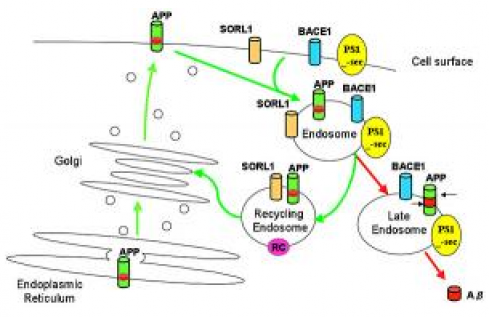This web page was produced as an assignment for Gen677, an undergraduate course at UW-Madison Spring 2009
Popular Press Review

This figure shows the proposed role SORL1 plays in determining the fate of amyloid precursor protein (APP). The figure and the accompanying article can be found online at Science Daily.
Below I review the online article "New Gene Uncovered For Late-onset Alzheimer's; Finding Replicated in Four Different Ethnic Groups" published January 15, 2007 on Science Daily. This article attempts to relay information to the public regarding the discovery by a multi-disciplinary team of researchers that the gene SORL1 is associated with Alzheimer's Disease.
Right from
the start the article “New Gene Uncovered For Late-onset Alzheimer's; Findings
Replicated In Four Different Ethnic Groups” published Jan. 15, 2007 on Science
Daily does a good job of not making any ridiculous claims such as “Gene Causing
Alzheimer’s Disease Discovered.”
Instead, they point out nuanced distinctions such as the results of the
study indicate that the relationship observed only applies late onset Alzheimer’s
Disease (AD). The article talks
briefly about the proposed function of sortilin-related receptor (SORL1), its
interactions with amyloid precursor protein (APP) and this may effect AD but
this discussion is quite brief and likely not going to be completely understood
by someone without a science background, but obviously overly simplistic for
someone working in the field.
Instead, the article swiftly transitions into details about subjects
used in the study and direct quotes from the study authors explaining the significance
of the study. I find this to be an
effective format because it allows the experts to explain the take home message
from the study as opposed to a journalist trying to figure it out and
potentially getting it wrong.
Science
Daily does an above average job of describing the experimental logic to the
reader. As was stated by Kua et.
al., readers think of science as this linear process instead of the circular
process that in reality it often becomes.
While it may be difficult in this short of an article to fully capture
the elegance of an experiment, this popular press article does a more than
cursory investigation of the scientific process including evaluating a priori
hypotheses and how this guided the experiment. This is important because while the conclusions drawn from
an experiment are important, often the methods used are more valuable for
future application in science.
This introductory explication of methods in the popular press helps
debunk the notion that “…science is a collection of facts that scientists spot
and that journalists convey to the public…”(Rowan, 1999 in Kua et. al., 2004).
When
explaining the findings of the scientific study, the Science Daily article
properly mentions one of the key design elements of the study that improves the
robustness; namely, the fact that the study examined four different ethnic
groups to solidify the conclusion.
This evidence further shows that the role SORL1 plays in AD supports the
belief that the link between gene and disease is not simply due to some
secondary or tertiary connection but is more likely due to a primary role in
disease etiology. Furthermore,
describing the immense efforts of the scientists (the study involved 6,000
patients) helps convey to the public the amount of work and evidence that went
into making the claims that the scientists make.
One pitfall
that this article avoids is simply becoming a review of what Alzheimer’s
Disease is and whom it affects. If
that were the focus of this article it would do a disservice to is explicit
purpose of describing the discovery of a link between a gene (SORL1) and a
disease (Alzheimer’s Disease).
Practically the only distinction made about AD in this article is
between early and late onset AD.
However, this is important to note because the findings in the
scientific article are only applicable to late onset AD, so informing readers
about the difference is within the scope.
Overall, this article does an adequate job of performing the three tasks
of a science reporter proposed by Kua et. al., being an “intermediary, a
watchdog, and a tool-giver.”
References
Kua, E., Reder, M., Grossel, M.J. (2004). Science in the news: a study of reporting genomics. Public Understanding of Science, 13, 309-322.
Science Daily: New Gene Uncovered For Late-onset Alzheimer's; Findings Replicated In Four Different Ethnic Groups.
Email: [email protected]
Last Updated 5/13/09
Genetics 677 Homepage
